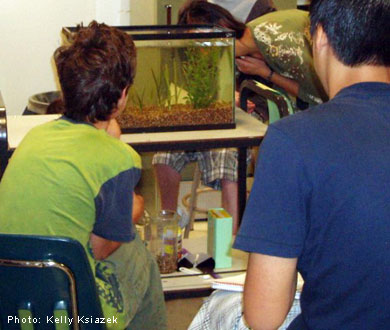 Students observe the feeding behavior and success rate of blue gill feeding on brine shrimp in two different environments; one with seagrass and one without.*
Students observe the feeding behavior and success rate of blue gill feeding on brine shrimp in two different environments; one with seagrass and one without.*
*See "Predator Prey Interaction" for a cheaper alternative activity that can be used without the living organisms.)
Objective
Students will gain a better understand of the following ecological service provided by underwater grasses: underwater grasses provide shelter for wildlife.
Materials
- 2 tanks
- 2 Air pumps
- Seagrass or other aquatic plant, such as jungle vallisneria (Vallisneria Americana), or tall artificial aquarium plants for one of the tanks. It can be ordered online from That Pet Place and shipped via FedEx. Please see the Lesson Resources section for ordering information.
- Light source
- Small sized gravel/sand
- 2 buckets for keeping the bluegill before/after the experiment
- Disposable pipette with top cut off
- Net for catching fish and brine shrimp
- 2 bluegill for each class (can be ordered from science supply companies, such as Carolina Biological Supply)
- Live brine shrimp for pre-feeding and for the actual experiment (Do not use frozen ones, as they will just hang from the grass or fall to the bottom of the tank. Live brine shrimp can usually be bought from a local fish or pet store or ordered from science supply companies such as Carolina Biological Supply. Please see the Lesson Resources section for ordering information.)
- Other fish food/filters for taking care of the fish
Procedure
- Two freshwater tanks will need to be set up a few days before your fish arrive. Both tanks should be covered with a layer of sand or gravel on the bottom and should have an oxygen pump and carbon filter.
- In one tank, underwater grass such as jungle vallisneria (Vallisneria Americana) should be established, while the other tank should be grass-free. For this experiment, artificial grasses could also be used to illustrate the main ideas.
- You will need at least 2 bluegills (Lepomis macrochirus) for each class period. They should be in the tank with out the grass for about a week in order to acclimate.
- You will need about 2 dozen live brine shrimp for each class period plus extras for feeding the bluegill before and after the experiment. They generally will not live for more than a week, so have them sent right before you need them.
- The bluegill should not be fed for 24 hours before the experiment to ensure that they are hungry.
- On the day of the experiment, have 2 small buckets, one labeled “Hungry” and one labeled “Fed.” All of the fish should be removed from the tank and placed in the hungry bucket.
- At the beginning of each class period, one fish should be put in the grass tank and one should be out in the grass-free tank. They will need a little time to acclimate so the tanks should not be bumped or otherwise disturbed.
- Using a pipette, extract about a dozen brine shrimp from their container and squirt them into a petri dish. Have the students count out 12 brine shrimp and return the extras to the stock container. Repeat this with a second petri dish
- When the students are ready to observe carefully, dump the brine shrimp from one petri dish into each tank and observe for 15 minutes. Students will need to count how many shrimp are eaten after each minute and record the data following the format in the Student Worksheet, available below. The bluegill may take a couple minutes to get acclimated or start consuming prey and the tank should not be disturbed (bumped) during the feeding time.
- After 15 minutes, disturb the tank by bumping it, remove the fish, and place them in the “Fed” bucket. Students should make sure to get data from both tanks and they should find that the grass serves as protection for the brine shrimp. Brine shrimp should survive better and longer in the protected environment.
- If there are still brine shrimp left in the tanks, remove them and put them back in the stock containers before restarting the experiment. If you are going to do this experiment with another class, one new “Hungry” bluegill should be placed in each tank to start acclimating again.
The bluegills may live for many months, so if you do not wish to maintain a fish tank in your classroom, ask the students if they would like to adopt some new pets! They should NOT be released into the wild.
References
- That Pet Place Website for ordering grass: http://www.thatpetplace.com/pet/cat/info/23204/category.web “Jungle Vallisneria” or Vallisneria americana, Item #YH:208853
- Carolina Biological Supply Website for ordering Bluegill and Brine Shrimp: http://www.carolina.com/home.do (Bluegill Item #145410, Live Brine Shrimp Item #142230)
National Science Education Standards
9-12 A. Science as Inquiry
- Understandings about scientific inquiry
9-12 C. Life Science
- Interdependence of organisms
- Behavior of organisms
9-12 F. Science in Personal and Social Perspectives
- Environmental quality
- Science and technology in local, national, and global challenges